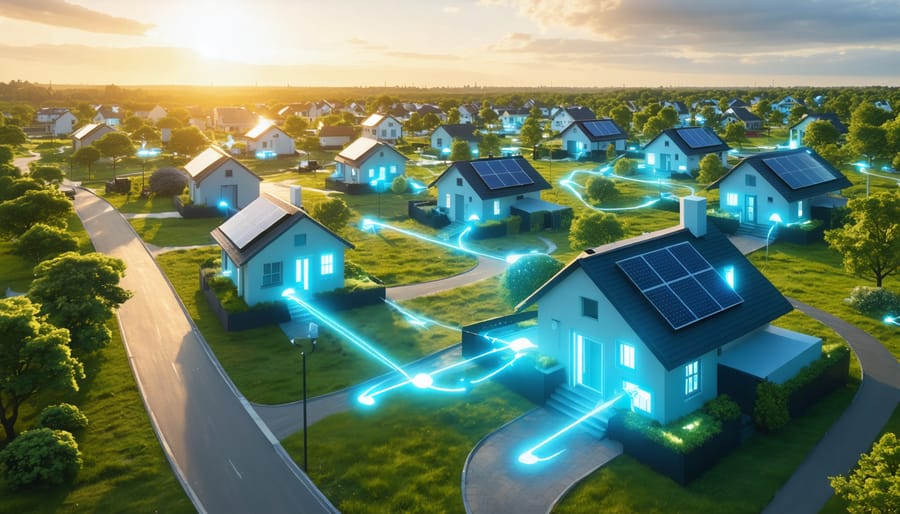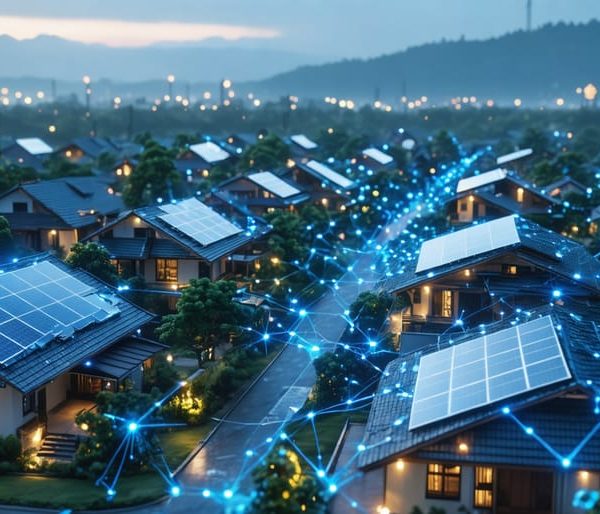Power Your Home Better: How Decentralized Solar Networks Transform Energy Storage
Transform your home into an energy-independent powerhouse with decentralized power systems – the future of sustainable living that’s already here. By combining solar energy storage with smart distribution networks, homeowners are breaking free from traditional grid dependencies while reducing their carbon footprint and utility costs.
Think of decentralized energy as your personal power ecosystem: solar panels capture sunshine, batteries store excess power, and intelligent systems manage distribution exactly when and where you need it. This revolutionary approach isn’t just about energy independence – it’s about creating resilient communities that can maintain power even during grid outages.
Unlike conventional centralized systems that rely on distant power plants and vulnerable transmission lines, decentralized networks put you in control. Whether you’re a homeowner looking to slash electricity bills or a business owner aiming to enhance operational reliability, these systems offer a practical path to energy autonomy while contributing to a more sustainable future.
Ready to join the energy revolution? Let’s explore how decentralized power can transform your property into a self-sustaining energy hub.
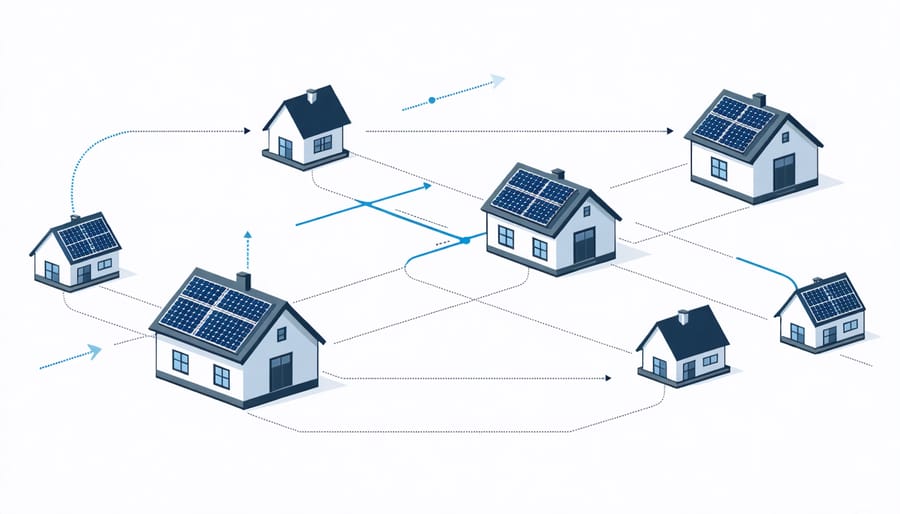
Why Decentralized Solar Storage Makes Sense for Homeowners
Energy Independence and Grid Resilience
Decentralized energy systems offer a powerful path to energy independence by reducing reliance on traditional power grids. Instead of depending on a single, centralized power source, these systems create a network of independent energy producers and consumers. When combined with smart grid technology, they provide remarkable resilience against power outages and grid failures.
Think of it as having your own power plant right at home. During storms, grid failures, or other emergencies, your system continues generating and storing energy, keeping your lights on while others might be in the dark. This independence is particularly valuable in remote areas or regions prone to natural disasters.
The system’s flexibility also helps balance energy supply and demand more effectively. When one area produces excess power, it can share with neighbors who need it. This cooperative approach creates a more stable and reliable energy network, reducing the strain on traditional infrastructure while building stronger, more resilient communities.
For businesses and homeowners alike, this means fewer disruptions, lower energy costs, and greater control over their power supply.
Cost Savings Through Network Sharing
Participating in a decentralized solar storage network offers substantial financial advantages beyond individual solar installations. By joining forces with other homeowners in your community, you can significantly reduce your energy costs through shared resources and optimized energy distribution.
When multiple households pool their solar storage capacity, the network becomes more efficient and resilient. During peak production hours, excess energy can be shared among participants, eliminating waste and maximizing return on investment. This collaborative approach also reduces individual infrastructure costs, as participants share maintenance expenses and can invest in larger, more efficient storage systems collectively.
Network participants typically report 20-30% greater savings compared to standalone systems. These savings come from reduced equipment costs, shared maintenance expenses, and more efficient energy utilization. Additionally, many utility companies offer special incentives for networked systems, recognizing their positive impact on grid stability and sustainability. The ability to trade excess energy within the network also creates opportunities for passive income, making the investment even more attractive for forward-thinking homeowners.
Building Your Home Solar Storage Network
Essential Components and Setup
Setting up a decentralized energy system requires several essential components working together seamlessly. At the heart of the system are solar panels, which capture sunlight and convert it into electricity. As outlined in our comprehensive home solar installation guide, you’ll need high-quality photovoltaic panels mounted on your roof or ground-mounted frames.
Energy storage is crucial for system reliability. Deep-cycle batteries, particularly lithium-ion or advanced flow batteries, store excess energy for use during cloudy days or nighttime. A smart inverter system converts DC power from solar panels and batteries into AC power for your home appliances while managing power flow between components.
The system’s brain is its energy management system (EMS), which monitors power generation, storage levels, and consumption patterns. This smart controller optimizes energy use and automatically switches between power sources as needed.
Additional components include:
– Charge controllers to prevent battery overcharging
– Safety disconnects and circuit breakers
– Smart meters for monitoring system performance
– Weather-resistant wiring and conduits
– Mounting hardware and support structures
Professional installation ensures all components are properly integrated and meet local building codes. Regular maintenance keeps your system running efficiently for years to come.
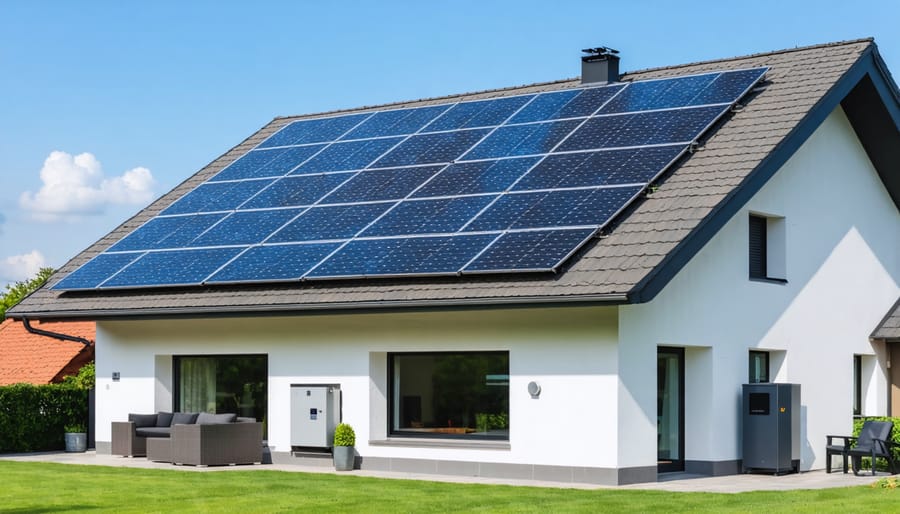
Smart Integration Technologies
Modern decentralized energy systems rely heavily on sophisticated integration technologies that make managing your energy storage and distribution as simple as using a smartphone app. These smart solutions combine advanced hardware components with user-friendly software interfaces, giving you complete control over your energy usage.
At the heart of these systems are smart inverters and energy management systems (EMS) that automatically optimize power flow between your solar panels, battery storage, and home appliances. Think of it as having a personal energy assistant that decides when to store excess solar power, when to use battery reserves, and when to draw from the grid – all to maximize your savings and efficiency.
Many of these systems now come with intuitive mobile apps that let you monitor your energy production and consumption in real-time. You can track how much power your solar panels are generating, check battery levels, and even control smart appliances remotely. Some advanced systems use artificial intelligence to learn your energy usage patterns and automatically adjust settings for optimal performance.
The integration hardware includes smart meters, power optimizers, and automated switching systems that work seamlessly with your existing electrical setup. These components communicate with each other through secure wireless networks, creating a responsive ecosystem that adapts to your energy needs while maintaining grid stability.
For property managers, these technologies often include advanced features like load management and demand response capabilities, helping to reduce peak demand charges and optimize energy costs across multiple units or buildings.
Connecting with Neighboring Systems
Creating a local energy sharing network is easier than you might think, and it starts with reaching out to your neighbors. Begin by identifying other households or businesses in your area that already have solar panels or are interested in renewable energy. Local social media groups and community boards are excellent places to start these conversations.
Once you’ve found interested participants, organize a community meeting to discuss the potential of creating an energy sharing network. During this meeting, outline the benefits everyone can expect, such as reduced energy costs, increased grid resilience, and lower carbon footprints. It’s helpful to bring in a local solar installer or energy consultant who can explain the technical requirements and costs involved.
The next step is conducting a feasibility study of your neighborhood’s energy infrastructure. This includes assessing existing solar installations, determining grid connection points, and evaluating storage capabilities. Many utilities now offer programs specifically designed to support community energy sharing initiatives, so contact your local provider to learn about available options.
To formalize your network, establish clear agreements about energy sharing protocols, maintenance responsibilities, and cost-sharing arrangements. Consider forming a cooperative or neighborhood association to manage the system effectively. Remember to check local regulations and obtain necessary permits before connecting systems.
Starting small and scaling up gradually often works best. You might begin with just two or three connected properties and expand as more neighbors see the benefits in action.
Maximizing Your System’s Efficiency
Energy Monitoring and Management
Modern energy monitoring and management tools are the brains behind efficient decentralized energy systems. These smart solutions help you track, analyze, and optimize your energy production and consumption in real-time, putting you in complete control of your power usage.
Smart meters and energy monitoring devices provide detailed insights into your energy patterns, showing exactly when and where you’re using the most power. This data is typically accessible through user-friendly mobile apps or web platforms, making it easy to check your system’s performance from anywhere.
Many monitoring systems now feature AI-powered analytics that can predict energy needs based on your usage patterns and weather forecasts. These intelligent systems can automatically adjust power distribution, storing excess energy during peak production times and releasing it when needed most.
For homeowners, this means you can schedule energy-intensive activities like running your dishwasher or charging your electric vehicle during times of peak solar production. Property managers can use these insights to optimize building operations and reduce costs across multiple properties.
The best part? Most modern monitoring systems send automated alerts when they detect unusual patterns or potential issues, helping you prevent problems before they affect your power supply. They can also generate detailed reports showing your energy savings and environmental impact, making it easier to track your progress toward sustainability goals.
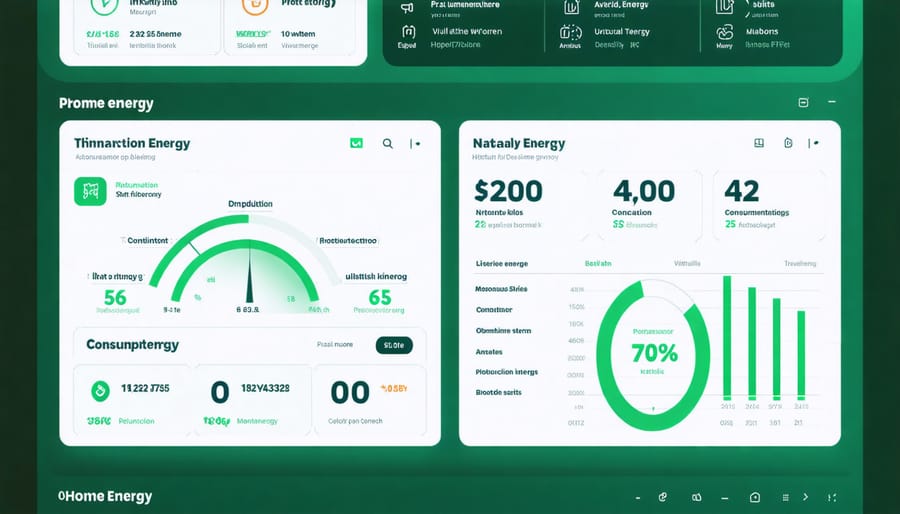
Maintenance and Upgrades
Regular maintenance is key to keeping your decentralized energy system running efficiently. Most components require simple quarterly checks, including cleaning solar panels, inspecting batteries, and verifying connections. Set reminders for these routine tasks to ensure optimal performance and longevity of your system.
Battery maintenance typically involves checking fluid levels (for certain types), cleaning terminals, and monitoring charge levels. Solar panels need occasional cleaning to remove dust and debris, which can impact their efficiency. During winter, ensure panels are clear of snow and ice buildup.
Modern monitoring systems make maintenance easier by alerting you to potential issues before they become problems. Many systems come with smartphone apps that track performance and notify you when maintenance is needed. This proactive approach helps prevent system downtime and extends equipment life.
As technology evolves, consider periodic upgrades to enhance your system’s capabilities. Popular upgrades include:
– Adding smart energy management systems
– Increasing battery storage capacity
– Installing more efficient solar panels
– Implementing advanced monitoring tools
– Integrating new renewable energy sources
When planning upgrades, consult with qualified professionals to ensure compatibility with your existing setup. Many homeowners start with a basic system and gradually expand it as their energy needs grow or as new technologies become available. This modular approach makes decentralized energy systems highly adaptable to changing requirements and technological improvements.
Real Success Stories
The Brooklyn Microgrid project stands as a shining example of decentralized energy in action. Launched in 2016, this community-based initiative allows neighbors to buy and sell locally generated solar energy directly from each other. Within its first year, the project connected 50 households and reduced participating homes’ energy bills by an average of 15%.
In rural India, the Dharnai village transformed its energy landscape through a decentralized solar network. Before implementation, the village had no reliable electricity. Today, 450 households enjoy 24/7 power access, powering homes, shops, and agricultural operations. The system generates 224 kilowatts of solar energy and has created local jobs for maintenance and operations.
The Australian town of Onslow demonstrates how decentralized energy can work on a larger scale. Their Distributed Energy Resource (DER) project combines residential solar installations with a centralized solar farm and battery storage system. During peak sunlight hours, the town often runs on 100% renewable energy, and residents have seen their electricity costs decrease by up to 40%.
In Germany, the Feldheim community achieved complete energy independence through its decentralized system. The village combines wind turbines, solar panels, and biogas facilities to generate more electricity than it needs. Residents pay 31% less for electricity compared to the national average, and excess energy is sold back to the grid, creating community revenue.
The LO3 Energy project in Texas demonstrates how blockchain technology enhances decentralized energy systems. Their peer-to-peer energy trading platform connects 700 homes, allowing participants to automatically buy surplus solar power from neighbors. The system has reduced grid dependency by 35% and saved participants an average of $420 annually on energy costs.
These success stories showcase how decentralized energy systems not only provide environmental benefits but also deliver tangible economic advantages to communities while increasing energy independence and reliability.
As we’ve explored throughout this article, decentralized energy systems represent a powerful shift in how we think about and consume energy. By taking control of our energy production and storage, we’re not just reducing our carbon footprint – we’re building a more resilient and sustainable future for our communities.
The benefits are clear: lower energy costs, increased energy independence, and improved grid reliability. Whether you’re a homeowner looking to reduce your monthly bills or a business owner aiming to enhance your property’s value, decentralized energy systems offer practical solutions that make economic and environmental sense.
Remember, transitioning to a decentralized energy system doesn’t have to be overwhelming. Start small with solar panels and basic storage solutions, then gradually expand your system as your needs and budget allow. Many communities now offer incentives and support programs to help you get started, making the initial investment more manageable than ever.
The time to act is now. Climate change and rising energy costs aren’t waiting, and neither should you. By joining the decentralized energy movement, you’re not just investing in your property – you’re investing in a cleaner, more sustainable future for generations to come.
Take the first step today by consulting with local renewable energy experts or joining community energy initiatives. Together, we can build a more resilient and sustainable energy future, one system at a time.

